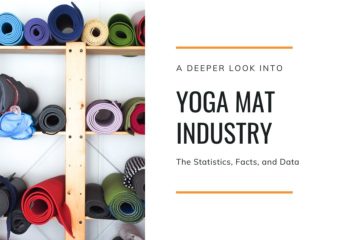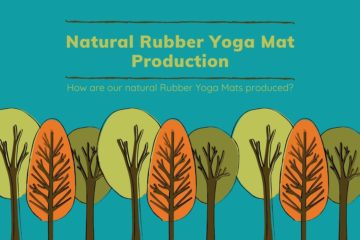Not all yoga mats are created equal. Some are more environmentally friendly; others are more durable. When searching for the perfect yoga mat, you have to weigh the benefits and disadvantages of the many types available.
As everyone knows, there are several common yoga mats on the market, including TPE/PVC/NBR/Jute/Cork/Natural Rubber/EVA/Cotton/Wool yoga mats. Let’s get to learn the difference of yoga mat materials.
Summary of Contents
DIFFERENT TYPES OF YOGA MAT MATERIALS
1. Natural Rubber Yoga Mat
Natural rubber mats are made sustainably with natural rubber tapped from rubber trees, a renewable resource and unlike other mats contains EVA or other synthetic rubber. In a sense, natural rubber mat is everything a yogi want in a yoga mat – eco-friendly, incredible grip and great comfort. This mat also has antimicrobial properties that help keep it clean.
Natural rubber mats are crafted of natural rubber — a fully sustainable and easily renewable source. Extracted from rubber trees, these mats are durable, but they’re also heavy and take a long time to dry out if they get wet. Rubber is comfortable on the body, however, and makes the perfect surface on which to perform yoga. If you’re someone who’s allergic to latex, however, there might be a slight chance that rubber could cause an allergic reaction.
2. TPE Yoga Mat
TPE (Thermoplastic Elastomers) yoga mats are made of polymers, a type of plastic with thermic and elastic properties. TPE materials can be easily moulded, extruded and reused. However, they are not recyclable.
TPE doesn’t require reinforcing agents, stabilizers or even cure systems making it less reactive and polluting than PVC. So a better alternative to PVC.
Disadvantages to TPE include the fact that while it contains no PVC or latex, it’s still manufactured using heat and chemical processes. It’s also still a synthetic product. TPE is often used in yoga mats that combine materials. It may serve as the bottom layer of a mat that’s crafted mainly from cork or cotton fabric, for instance. And mats made from TPE are typically quite affordable. TPE mats are easy to clean and care for as well, simply spray with an organic cleaner and wipe dry.
3. PVC Yoga Mat
PVC yoga mat is made of PVC resin powder. PVC mats are usually produced with low quality for the lowest cost.
However, yoga mats made from PVC have several advantages if the PVC material is high density and high quality. For example, ProLite (Manduka) or b’ROCK (Beinks) yoga mats use high-density PVC. These types of mats are often noted for their thick cushioning, resistance to moisture and non-skid coatings. They score high on comfort and functionality, but at the same time, they’re deceptively easy to clean. Additionally, they hold up exceptionally well.
4. NBR Yoga Mat
NBR it’s a synthetic rubber commonly used in the automotive and aeronautical industry. It has become popular among yoga mats as it provides good insulation and cushioning.
NBR manufacturing isn’t environmentally friendly. In fact, it’s manufacturing is limited in Europe, USA and Canada due to the toxic substances used to produce it, such as Butadiene.
Mats made of NBR are crafted of a synthetic type of rubber that’s not naturally harvested, but rather manmade. NBR can degrade if it has some additives added to accelerate the process.
5. Jute Yoga Mat
Jute is a natural fibre from a plant form the Corchorus genus. It’s second to cotton in the amount produced and variety of uses. Jute is a rain-fed crop with little need for fertilizer or pesticide, in contrast to cotton’s heavy requirements. Production is concentrated mostly in Bangladesh, as well as India’s states of Assam, Bihar, and West Bengal.
This yoga mat has one side of Jute and another of PVC or PER. PER stands for Polymer Environmental Friendly Resin.
PER is friendlier than PVC and less damaging to the environment compared to PVC. PER is essentially PVC which has been plasticized and stabilized with acetyl tributyl citrate, instead of phthalate-based plasticizers (DEHP) whose endocrine-disrupting properties give PVC its bad reputation.
6. Cork Yoga Mat
Cork is a natural material made from the cortex of the oak tree. It is a renewable resource that doesn’t damage the trees during its harvesting.
Cork yoga mats tend to have one side made of cork and the other from different material to make them non-slippery on the floor surface. The bottom layer is often made of TPE or Natural rubber material.
7. EVA Yoga Mat
Ethylene-vinyl acetate makes up the EVA yoga mat. It’s a synthetic material that’s both lightweight and resistant to cracking. EVA yoga mats are moisture-resistance and easy to wipe clean after your session. Thinner versions may tend to stretch a bit, however, as you work out.
EVA contains chemicals and odors that can be undesirable. Widely used in the construction of flip flops, EVA is also used in many types of floor mats, including those used in gyms and schools. If you’ve ever purchased those puzzle-like pieces of foam mat at the toy store, you’ve probably encounted EVA foam. It’s soft and pliable, but may become flat and less serviceable with frequent use.
8. Cotton Yoga Mat
The production of cotton has a high environmental impact due to the use of pesticides, fertilizers, and the use of huge amounts of water. Some cotton crops are genetically modified. These crops require herbicide glyphosate, which poses risks to our health and the environment.
As an alternative, we can choose organic cotton. The production of organic cotton does not use pesticides, chemical fertilizers and relies on rainfall.
9. Wool Yoga Mat
Wool is a sustainable resource that does not harm sheep in the process. If the wool is organic it benefits the small producers and has a low impact on the environment. Wool yoga mats are recommended for calmer types of yoga such as Yin yoga, Kundalini yoga, Mantra yoga, Meditation and Relaxation.
COMPARE: TPE vs. PVC vs. NATURAL RUBBER
TPE, PVC, and rubber yoga mats are the most popular yoga mat types as of now. Sometimes, deciding between them can be a hard decision, as there are more factors to consider than you may initially think. If you want to decrease your eco-footprint, you may opt for a different yoga mat type, but maybe sacrifice on other features. Or, you may want a better performing yoga mat, even though it is more harmful to the environment.
Check out the table below! It details all the pros and cons of the TPE, PVC, and rubber yoga mats. Maybe the table will help you with your final purchase!
| Material | Pros | Cons |
| Natural Rubber |
|
|
| TPE (Thermal Plastic Elastomer) |
|
|
| PVC (Poly-Vinyl Chloride) |
|
|
The content was compiled from these sources: Disruptsports & BHSYoga & Alexlarryngton.com




[…] days when yoga became more and more popular in the whole world, towels and cotton or rubber mats were used. They come in a vast array of colors, patterns and styles. Some are eco-friendly, while […]
[…] There are much more materials other than PVC and rubber. Explore 9 yoga mat materials here. […]